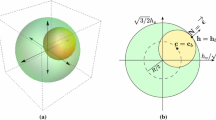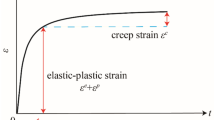Abstract
The creep degradation is a common phenomenon for soft structured clays. In this paper, the creep degradation behavior for soft structured clays is first studied by combining intrinsic creep behavior and the structure indicator. A creep-implicit model and a creep-explicit model corresponding to a stress-based and a creep-based structure indicators are developed, respectively, under one-dimensional condition. Parameters determination for both models is straightforward from oedometer tests. Coupled with consolidation theory, both models are used to simulate oedometer tests with different structural levels and load durations on three clays. The predictive ability of the two models on creep behavior, creep degradation behavior and evolution of structure indicator is analyzed. The relationship between the two structure indicators is discussed based on experimental results. The comparison between experimental and numerical results demonstrates that both models can accurately describe the creep degradation behavior of soft structured clay under one-dimensional loading.















Similar content being viewed by others
References
Berry PL, Poskitt TJ (1972) The consolidation of peat. Géotechnique 22(1):27–52
Burland JB (1990) On the compressibility and shear strength of natural clays. Géotechnique 40(3):329–378
Gens A, Nova R (1993) Conceptual bases for a constitutive model for bonded soils and weak rocks. In: Proceedings of international symposium on hard soils—soft rocks, Athens, pp 485–494
Graham J, Crooks JHA, Bell AL (1983) Time effects on the stress–strain behaviour of natural soft clays. Géotechnique 33(3):327–340
Hinchberger SD, Qu G (2009) Viscoplastic constitutive approach for rate-sensitive structured clays. Can Geotech J 46(6):609–626
Karstunen M, Yin Z-Y (2010) Modelling time-dependent behaviour of Murro test embankment. Géotechnique 60(10):735–749
Kim YT, Leroueil S (2001) Modeling the viscoplastic behavior of clays during consolidation: application to Berthierville clay in both laboratory and field conditions. Can Geotech J 38(3):484–497
Kimoto S, Oka F (2005) An elasto-viscoplastic model for clay considering destructuralization and consolidation analysis of unstable behaviour. Soils Found 45(2):29–42
Kutter BL, Sathialingam N (1992) Elastic–viscoplastic modelling of the rate-dependent behaviour of clays. Géotechnique 42(3):427–441
Leroueil S, Kabbaj M, Tavenas F (1988) Study of the validity of a σ′v − εv − dεv/dt model in site conditions. Soils Found 28(3):13–25
Leroueil S, Kabbaj M, Tavenas F, Bouchard R (1985) Stress—strain–strain rate relation for the compressibility of sensitive natural clays. Géotechnique 35(2):159–180
Leroueil S, Tavenas F, Brucy F, La Rochelle P, Roy M (1979) Behaviour of destructured natural clays. J Geotech Eng ASCE 105(6):759–778
Mesri G, Godlewski PM (1977) Time and stress-compressibility interrelationship. J Geotech Eng ASCE 103(5):417–430
Oka F, Adachi T, Okano Y (1986) Two-dimensional consolidation analysis using an elasto-viscoplastic constitutive equation. Int J Numer Anal Meth Geomech 10(1):1–16
Perzyna P (1966) Fundamental problems in viscoplasticity. Adv Appl Mech 9:243–377
Rocchi G, Fontana M, Da Prat M (2003) Modelling of natural soft clay destruction processes using viscoplasticity theory. Géotechnique 53(8):729–745
Smith PR, Jardine RJ, Hight DW (1992) On the yielding of Bothkennar clay. Géotechnique 42(2):257–274
Stolle DFE, Vermeer PA, Bonnier PG (1999) A consolidation model for a creeping clay. Can Geotech J 36(4):754–759
Vermeer PA, Stolle DFA, Bonnier PG (1997) From the classical theory of secondary compression to modern creep analysis. In Proceedings of the 9th international conference on computer methods and advances in geomechanics, Wuhan/China. Balkema, Rotterdam, pp 2469–2478
Yin JH, Zhu JG, Graham J (2002) A new elastic viscoplastic model for time-dependent behaviour of normally and overconsolidated clays: theory and verification. Can Geotech J 39(1):157–173
Yin Z-Y, Chang CS, Karstunen M, Hicher P-Y (2010) An anisotropic elastic viscoplastic model for soft soils. Int J Solids Struct 47:665–677
Yin Z-Y, Hicher PY (2008) Identifying parameters controlling soil delayed behaviour from laboratory and in situ pressuremeter testing. Int J Numer Anal Meth Geomech 32(12):1515–1535
Yin Z-Y, Karstunen M, Chang CS, Koskinen M, Lojander M (2011) Modeling time-dependent behavior of soft sensitive clay. J Geotech Geoenviron Eng 137(11):1103–1113
Yin Z-Y, Karstunen M, Hicher P-Y (2010) Evaluation of the influence of elasto-viscoplastic scaling functions on modelling time-dependent behaviour of natural clays. Soils Found 50(2):203–214
Yin Z-Y, Wang JH (2012) A one-dimensional strain-rate based model for soft structured clays. Sci China Technol Sci 55(1):90–100
Yin Z-Y, Xu Q, Yu C (2012) Elastic viscoplastic modeling for natural soft clays considering nonlinear creep. Int J Geomech. doi:10.1061/(ASCE)GM.-5622.0000284
Yin Z-Y, Yin JH, Huang HW (2015) Rate-dependent and long-term yield stress and strength of soft Wenzhou marine clay: experiments and modeling. Mar Georesour Geotechnol 33(1):79–91
Zeng LL (2010) Deformation mechanism and compression model of natural clays. Doctoral Thesis. Southeast University, China
Zhang XW, Wang CM (2012) Effect of soft clay structure on secondary consolidation coefficient. Rock Soil Mech 33(2):476–482
Zhu GF, Yin JH (1999) Finite element analysis of consolidation of layered clay soils using an elastic visco-plastic model. Int J Numer Anal Meth Geomech 23(4):355–374
Zhu QY, Yin Z-Y, Hicher PY, Shen SL (2015) Non-linearity of one-dimensional creep characteristics of soft clays. Acta Geotech 11(4):887–900. doi:10.1007/s11440-015-0411-y
Acknowledgements
We acknowledge with gratitude the financial support provided by the National Natural Science Foundation of China (Grant Nos. 41372285, 51579179, 41502271), the Region Pays de la Loire of France (project RI-ADAPTCLIM) and State Key Laboratory for GeoMechanics and Deep Underground Engineering, China University of Mining & Technology (SKLGDUEK1714).
Author information
Authors and Affiliations
Corresponding author
Rights and permissions
About this article
Cite this article
Yin, ZY., Zhu, QY. & Zhang, DM. Comparison of two creep degradation modeling approaches for soft structured soils. Acta Geotech. 12, 1395–1413 (2017). https://doi.org/10.1007/s11440-017-0556-y
Received:
Accepted:
Published:
Issue Date:
DOI: https://doi.org/10.1007/s11440-017-0556-y




